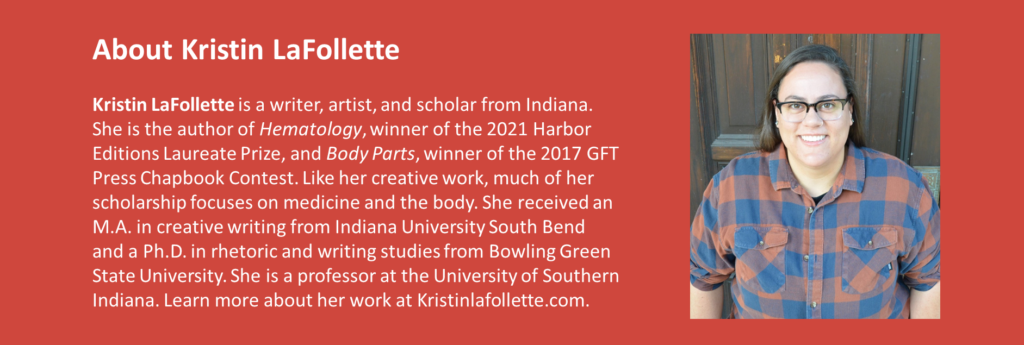An Introduction to Poems from Hematology
In the early morning of August 1, 2017, I sat in a hospital waiting area with my parents and younger brother. We were awaiting the arrival of my older brother and sister-in-law’s daughter, my niece, the first grandchild in both families. I am my parents’ only daughter, the middle child wedged between two boys, and while I love my brothers deeply and feel connected to them in a way that’s difficult to describe, I’ve often wondered what it would have been like to have a sister. In that waiting area, I couldn’t stop thinking about the unearthing of this new girl-child, a girl who might look like me, be like me. I wrote the first draft of “Hematology” during this period of waiting and, at its core, the poem is about what families share. It’s an exploration of blood as a source of connection. It’s also a poem about welcoming, anticipation, gratitude: “If another girl is born, I will be thankful for one more thing to / keep me here.”
When I was deciding on a title for the book “Hematology” appears in, I considered the many intersecting threads in the poems. There are three distinct sections, and the first centers on lineage, family histories and relationships, and, as one of the blurbs on the back cover of the book notes, “what families share and what they don’t, what blood can rouse and what it can’t.” The second section focuses on the messiness of living and existing in a body as the speaker grapples with illness, injury, and anxiety, and this grappling is often communicated through the loss of blood and mentions of “bloodletting,” “blood-flowers” forming into bruises, and “blood forced out of the / chamber.” If the second section is characterized by missing blood, the third section contains blood in abundance—blood as offering, as the basis for healing and wellness. To me, giving this book the name Hematology was the only way to encompass all of this: blood as connection, as inheritance, as necessity.
Several poems that have been posted or will be posted here, including “Hematology,” “Blue Boy,” “On Being the Daughter,” “The Organism’s Phenotype,” “Genetic,” and “A Confession,” are from the first section of the book. “Blue Boy” introduces the youngest sibling in my family, a brother born in December during a Midwestern blizzard. I was almost eight and my older brother was almost eleven when our baby brother came along, and “The Organism’s Phenotype” and “A Confession” are about being the older sibling and needing (but often failing) to protect this small boy. These two poems contain blood that is shared and spilled, given and cherished. Both “On Being the Daughter” and “Genetic” examine the role of women in families and the immense emotional, physical, and mental labor that they often give, but “Genetic” also explores shared family trauma and inheritance.
The other poems, “Something Dangerous,” “Plastic Cadaver,” and “Occupied,” are from the second section of the book. “Something Dangerous” and “Occupied” were written during and after a series of orthopedic surgeries I had between the ages of seventeen and twenty-four. In the poems, I question the soundness of my own body and outline the slow burden of recovery, how injury and illness stay with us and alter our bodies. “Plastic Cadaver” is a personal history of my interests in medicine and writing. My last year of high school, I worked in various hospital and clinical settings as part of an internship program for students in the medical field and, for the first three years in college, I was a pre-med major with plans to attend medical school. Going into my final year, I questioned what I truly wanted to do with the rest of my life. I had always loved writing, and conversations with my advisor led me to test the waters as an English major. The first creative writing class I took helped me see the ways I could intersect my interests in medicine and writing, and Hematology is a tangible example of this. As a poet-friend wrote in her blurb for the book, “the collection bleeds and lets [readers] see the mess, too.”

Acknowledgements
This excerpt from Hematology is shared with permission of the author, Kristin LaFollette, and Harbor Editions.

.
